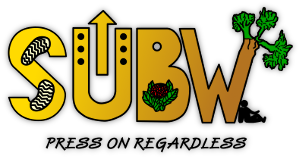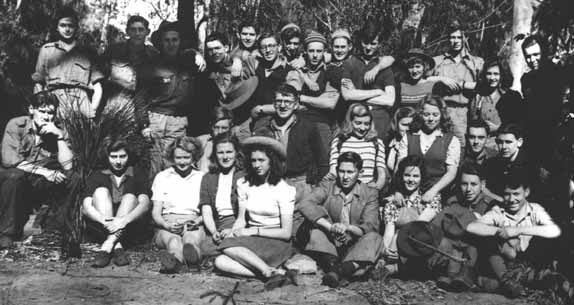by Allan Maccoll
The unofficial history started ca 1935 when some chemistry students noticed in the SRC Handbook a reference to the Geological Society which stated as one of its aims ‘the encouragement of intercourse social and otherwise’. The walks were totally unofficial and the patron saint was Paddy Pallin. Some of the foundation members were Arthur Birch1,2,3 (appointed OA), Dick Blake, Frank Boileau, Des Brown1 and Jan (née Harrison, sculptor), Hugh Cameron (famous for his cry from a very steep descent ‘rope the women together’), Ken Cavill1, John1,2 (now Sir John and Nobel laureate) and Rita Cornforth (née Harradence), Helen Fenbury (née Sheils), Joyce Fildes, Marion Kentridge (née Riley), Dave McGrath, Bill McNiven, Margaret Riley (later Margaret Maccoll, appointed ISO), Ron (later Sir Ronald) Nyholm1,2 Ken Sewell, Johnny Shaw, Albert Shulman, Ellis Thorpe, Dick Welch, Edith Waller (née Riley), and Jean White (née Murphy). John (Kappa) Cornforth was famed for his ability to tell the time by the stars and also by his ability to produce limericks on demand. One that remains in my memory is:
A physical fellow named Planck
Used to set up nine beers in a rank
And quantum by quantum
Proceed to decant ’em
Till under the table he sank
Some of the early walks were to Cox’s River, Bluegum Forest, and the Nattai River (Starlight’s track). The next stage was in the war years when to help the war effort the Chemistry Department introduced a four term year. This gave rise to a great spirit of cameraderie amongst the students and some of the younger lecturers and to a influx of new walkers. These included Gordon Ada1, Bill Donnelly, Ron Eade1, Hans Freeman1, Noel Hush1, Cliff Kratzing, Dave Morell, Grainger1 and Mollie Morris (née Nevitt), Lionel Murphy (High Court Judge), Ian Ross1 (Pro Vice Chancellor, ANU), Ed Salpeter1, Ray Stimson1, Jack Symes1 and Ted1 and Adrienne (née White) Thompson. Later members were David1,2,3 (appointed OA) and Ronia (née Bryden-Brown) Craig, and Warren Hill. Grainger Morris, being the tallest member of the party, was used on one of the walks as a depth sounder. It may have been the Shoalhaven which involved many river crossings. Grainger was sent over first to test the depth. The walks then became more ambitious. Kanangra Walls – I had an old 1926 Essex which I left on the track to Kanangra at the top of a slope which I hoped would suffice to turn over the engine. On returning to it we filled the radiator with boiling water and let it roll. It fired – about ten yards from the bottom to everyone’s relief. Kappa writes of another Kanangra Walls walk from a ridge leading up from the Kowmung ‘ we were all quite unprepared for what happened – a howling gale and a heavy snowstorm. We spent a miserable night in caves under the walls unavoidably facing the wind and in the morning we had the prospect of walking to Jenolan, in our sandshoes, through about 10 cm of snow, the first snow that some of us had seen. There was one bad time when the track lost itself in a large paddock and was retrieved at the far end after a search that seemed to last for ever. Night fell as we reached the height before the descent to Jenolan and we sought shelter at a farm and were received most kindly. As I remember the farmer’s name was R.I.Payne’.
On a trip to Kosciusko – we took the mail van to Khancoban – I well remember toiling up Hannel’s Spur and the Creel where we met Mr Sawkins a lecturer in statistics and a keen fisherman who presented us with some freshly caught trout. We also met Frankie Lions (lecturer in Organic Chemistry at the University of Sydney) who on trips lived on a diet of nuts and raisins! How many people would believe that we only met two people in the course of a week at Kosciusko! As I remember it we stayed in Seamans Hut and we visited the pub at Jindabyne, now unfortunately under water, where we were served beer out of a large teapot! Dried foods were a boon, especially potatoes and eggs. However we had some dried carrots (courtesy of CSIR) which we observed passed through the human system totally unchanged. It was on the Kowmung that we met with many black snakes of which we were initially afraid. After the first day we went chasing them (I guess it would be frowned on now). We walked up Church Creek and on to Yerranderie. We went to Mount Franklin before it was a ski resort – in fact a ski run had been cut but on the wrong slope – there was no snow on it! We were with the Cornforths and did a walk getting back or near back in the dark. We thought it safer to stay out rather than risk walking in unknown territory in the dark. We had two oranges and a cake of chocolate. In the morning we found the track only a few yards away. The Shoalhaven which I did with the late Ern Ritchie had its moments. It rained heavily and it is a tribute to our personalities that we remained friends though cooped up in a two man tent (Paddy Pallin) for two days, alternatively getting out and preparing a meal. Ern shot a pigeon and we put in the billy to stew. After a day when the meat was still too tough to eat we threw away the carcass and drank the soup! The group also attacked the Grose Valley from Bluegum. We were in the wake of a bush fire and the embers under ground were uncomfortably hot. It was quite a tough walk as I remember it. Colong Caves was another area we explored. In the early days we used to take groundsheet and blankets – no tent. However we soon saved up and bought a tent and sleeping bags. Joadja figures in my memory but the details escape me. Kappa’s memory helped out here. He writes ‘I was impressed by the miners’ cottages. With all that virgin bush around, they had made a terrace of little brick houses, each with its tiny brick-walled yard. It was years before, in England, I saw models for that conservatism – or was it nostalgia? We also found many shards of earthenware rum jars in the hills around the settlement’.
In all that time we were never lost, only somewhat displaced. I remember going down one of the Dog tracks from Clear Hill. It was a very hot day and after a few misguided forays we eventually reached the Cox. We were very thirsty and drank deep. Imagine our horror on finding a bloated remains of a cow as we walked upstream! They were good days and we learned a lot of bushcraft. We also learned about human nature. We had some very organised scroungers in the party who would always turn up when someone had cooked a good meal. I shall not mention names!
It is worth recording that when the ship carrying a number of post-war Fellows and Scholars berthed in Tilbury, a walking tour of Scotland was organised in the great summer of 1946. Once again no tents, but we got away with it! We saw Loch Affric before it was dammed and were surprised to find a property of about 40 000 acres in the UK.
It says something for the bushwalkers in that all of the marriages mentioned above have stood the test of time. Is this a record?
Memory being what it is I may have overlooked a number of people. I apologise for that.
I should also like to thank David and Ronia Craig for reading the manuscript and suggesting a number of incidents that I had overlooked.
1 Indicates those who ended up as professors or assistant professors.
2 Elected FRS.
3 Past President of the Australian Academy of Science.
|
I also sent Allan a few reminiscences which I believe he has incorporated in his article. But perhaps I can add one or two more: I used to take an interest in the plants that we encountered on our walks and there are two papers by me (in the Journal and proceedings of the Royal Society of New South Wales for 1939, Vol. 72, pp. 255-6 and 325-8) which were results of that curiosity. They both turned out to be quite interesting, especially the wild grape. Valerie May did the botanical identifications and complained, justly, that I hadn’t given her enough leaves or stems. The longest day’s march I ever did was when Dick Welch (he died in South Africa a few years ago) and I arrived early one Sunday morning at Jenolan and found that we couldn’t get transport that day. We wanted to be in Sydney by Monday and we knew that a train to Sydney left Mt.Victoria around midnight and we decided to catch it; the walk was around 70km if I remember right. We made it, and fell asleep in our seats on the way back while our leg muscles stiffened. It was agony to get going again and since we arrived so early we had to walk home from North Sydney station, Dick to Neutral Bay and I to Balmoral beach. I remember saying to Dick around the middle of the walk: “To-morrow, we’ll be laughing like hell at ourselves” and this was true. And I’ve never lost the taste for walking acquired in those days, and still walk around 8 km a day. John Cornforth |
|
|
|
SUBW – Party on the first club walk. Back row (l to r) – Bob Prior, Quentin Burke, Frank Taplin, Frank Peters, Jim McKillop, Ian Fitzpatrick, Vern Gilbert, Malcolm Stewart, Stuart Harris, Charlie Crossman, Billie Harrison, Mike Ney, Annette Astbury, Middle row – Neil Roberts, Kerras Burke, William Gilder, Kath Orsmby, Peg Magara, Shirley O’Donnell, Bob Mckenzie, John Oxenbould, Front row – Claire Aston, Margaret Whitfield, Marion Pegum, Pat Cummings, Phil Hordern, Jaqui Worledge, Hans Freeman, Ken McDonald. Photo – coutesy of Quentin Burke. |

